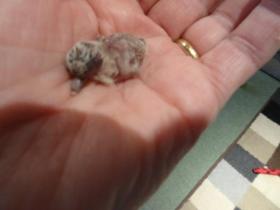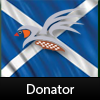-
Content Count
5,048 -
Joined
-
Last visited
Posts posted by Emmy
-
-
Mine too Lee and they can make some mess too

Emmy
-
 1
1
-
-
Hope you had a lovely birthday Claire (Sorry I'm a bit late)
Emmy
-
Hi Susan Welcome to the forum. It's the usual story (lol) you buy a pair of zebra finches and before you know it you begin to lose count of how many you have

Here's something you can try to stop the male plucking her feathers. Cut 6 /8 --10 cm lengths of normal parcel string - gather them together and fold them in half and put the loop through the cage wires and then pull the other part through the loop to secure to the cage and he will be more interested trying to pull the string apart and leave the female alone. This has worked for me before. Hope it's of some help to you
The wee ones can make some noise when they are letting 'mum' know they want to be fed.

Are you just going to keep zebra finches? I have a few different types of finches and other birds too.
At the moment I have some eggs in my incubator , found them on the bottom of my inside flight in the aviary and one was a diamond dove's egg and I had to help the tiny diamond dove chick out from its shell yesterday (it was stuck in shell and would have died if I hadn't helped it get out) and I'm now hand rearing it. I'll be feeding it (using a cocktail stick) every 2 hours for the first few days. This photo was taken when it was an hour old.

-
 1
1
-
-
Sorry I'm a bit late but hope you have a wonderful birthday Sarah
Emmy
-
( Andy-'Senior Moments'

 I think in my case I'd have to change the word 'moments' to 'repeated episodes'
I think in my case I'd have to change the word 'moments' to 'repeated episodes'  )
)
Would be really interesting to find out if anyone else has heard of this or tried it out.
Emmy
-
Andy Interesting suggestion about using dummy eggs and returning chicks problem would be though identifying sexes of the chicks when they had just hatched so they could be returned to the nest.- but the idea of turn up the heating in the shed could be tried if temperature could be set. I can see me trying this out at some point


Emmy
edited to add: Silly me!!
 of course the eggs/chicks could be returned to the nest just before they hatched/or just after hatching because the 3rd embryo stage would be over by then (put it down to 'slow to catch on'
of course the eggs/chicks could be returned to the nest just before they hatched/or just after hatching because the 3rd embryo stage would be over by then (put it down to 'slow to catch on'

 )
)
-
After talking to a number of people who breed finches etc. most were having a similar problem that the majority of the chicks were cock birds and very few hens hatching ( sometimes the broods were all cock birds).
Today I was looking through one of my books where I often write in any item of news/research etc. I find interesting and I found this:
" Changing temperature during incubation in the 3rd phase of embryo growth defines sex of chick-
Higher temperatures = females chicks
Slightly lower temperatures = male chicks
This works with reptiles and it has been known to work with hens and also with other species of birds although its more common where the eggs have been buried or a mound is built to raise the temperature for incubation.
Now lately the temperature has definitely been lower than normal could this be the reason for the increase of fewer female chicks?
Love to try this idea out but it would need more than 3/4 eggs in two separate incubators and if all the chicks survived-- what a lot of hand rearing would be involved


Emmy
-
Welcome to the forum Elbee. It's never-ending all the new things you discover about those little birds and nice to share information and photos. Hope you enjoy the forum looking forward to your posts.
Emmy
-
 1
1
-
-
Thanks Clare only problem is my obbb are all siblings (I still have their parents). Just thought I may just get a surprise (lol)
Emmy
-
Another beauty Trevor What pairing did that one come from?
I'm thinking of pairing up a bbob cock with cfw hen split for bc (she is showing signs of bc ) but part of me is thinking it may not be right to do that. BUT if I had put them into the outside flight they may have paired up on their own (million to one chance -lol)
Emmy
-
One day you should have a new mutation named after you. The results you are getting just don't happen overnight -hope all goes well with the next lot.
Emmy
-
It's another wee beauty Trevor Hope the others turn out well too.
Your work kinda makes this old saying wrong
 --
--
"Patience is a virtue, find it if you can, seldom in a woman but NEVER in a man"

Emmy
-
Great video Lee-- Happy Birdies

Emmy
-
 1
1
-
-
Thank you for posting the photographs I think they are so cute when they still have their black beaks.
Emmy
-
First I'd like to say 'Welcome the forum'
Are your young chicks still being fed by the parent birds? Do you put the egg food down to make it available to them all?
What I normally do is when the adult birds are feeding the young in the nest I give them a little egg food along with their normal seed every day and oyster grit is always available to them as well as cuttlefish.
When the chicks fledge I continue with the above and also give millet spray to encourage the chicks to peck on their own.
Once the chicks are separated from the parents For the first week I still give the egg food every day then gradually decrease the amount daily and then only give a little twice a week in finger feeder or a small container.
Hope this helps. from the description of the chicks they seem all to be pied - I love chicks like that. I have a variety of colours of finches and have some crested ones too. Any chance of you posting a photograph of the chicks ?
Emmy
-
Thanks for that idea
 I never would have thought of doing that with the millet spray so I'm going to have a go. I've always just added it to the drinking water -
I never would have thought of doing that with the millet spray so I'm going to have a go. I've always just added it to the drinking water -  must be old age creeping up because I've used that for years but just automatically mixed it up but this time I was thinking about what I was doing and couldn't remember if it was correct -- guess its better I don't stop and think!!
must be old age creeping up because I've used that for years but just automatically mixed it up but this time I was thinking about what I was doing and couldn't remember if it was correct -- guess its better I don't stop and think!!
Emmy
-
I have had a few DIS too and had more than usual of eggs that were not fertile also had 2 cockatiel eggs where the chick couldn't get out from the shell (should have intervened there sooner and helped them out) I was putting it down to the extreme changes in the weather and like you Andy I had no changes in their feeding.
(Andy wondering if you could remind me is it 1 teaspoonful of cider vinegar to a litre of water that can be given to the birds?)
Emmy
-
Fantastic video Gary - they sure were enjoying themselves- really enjoyed watching that. Thanks for sharing.
Emmy
-
-
Hi Ricky
If its the one sitting on the perch I think its a female.
Emmy
-
Hi InleGM
First I'd like to say Welcome to the forum.
There's a few things I could give you advice on but I hope others will jump in and correct me if I'm wrong. You didn't say the height of your cage but in my opinion you do need a larger cage for them.
It's not a good thing if they start to eat their eggs- could become a bad habit -this could mean if they did lay fertile eggs they would do the same with them.
When they have laid eggs in their nest they don't like their cage to be moved to a different position. Before I realised this In the past I have had them incubating eggs and moved their cage to different location and they came off the nest and didn't go back, even if they had live chicks in the nest if the cage was moved they didn't go back to feeding the chicks and if I hadn't hand reared the chicks they would have died---(I have Blog on here mentioning this- 'Hand Rearing Birds by Emmy')
They do like a 'bath' from time to time- this can be attached to the front of their cage or a shallow dish with water can be placed on the bottom of their cage
Re 'banding' I think you are meaning putting rings on their leg when they are young. I don't put closed rings on mine, which gives information when they hatched out etc. etc. when I do ring mine I use coloured split rings but this is just for my own information and wouldn't give information re who the bird belonged to. I'm sorry but I've no idea what happens re closed rings where you live.
I know I use the following if the birds start pecking each others feathers but it may divert them from eating eggs -don't know if it would though: Cut about 6/7 10cms lengths of normal parcel string and then fold it in half and loop it through the wires of the cage they love pecking at this.
Hope this gives you a little help.
Emmy
-
Another beauty Trevor
 Just waiting to find out what my Bengalese hatch out no idea what type they are incubating, only thing I do know is they will not be Bengalese
Just waiting to find out what my Bengalese hatch out no idea what type they are incubating, only thing I do know is they will not be Bengalese
Emmy
-
That one looks a right wee 'porker' bonny bird
Emmy
-
What a lovely wee bird Trevor.

Any more in the nest?
Emmy




Happy Birthday DaveP
in Birthday Greetings
Posted · Report reply
Happy Birthday Dave Wishing you all the best.
Emmy